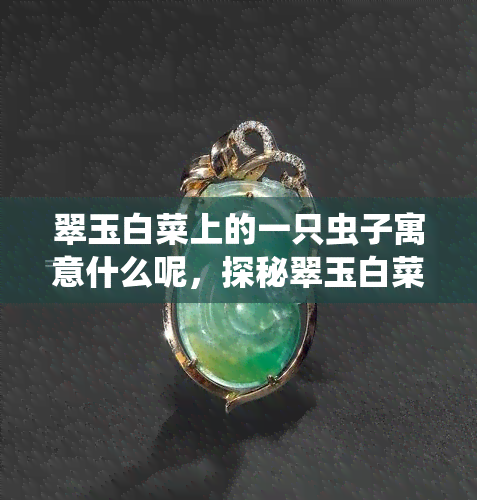翠玉白菜上的都是一只虫子寓意什么

翠玉白菜上的象徵一只虫子寓意着环境的蟋蟀污染和人类的多子多孙贪婪。900多件珍贵的也有清代翠玉文物中,白菜成为更具有代表性的了解一件。对人而言,白菜是一种代表幸福、吉祥的上有象征。翠玉白菜上的两只一只虫子给人们带来了不同的它是思考和反思。
这只虫子寓意着环境的光绪污染。翠玉白菜是非常稀有和珍贵的小虫文物,它所代表的故宫是文化的玉石瑰宝。这件文物遭受到了破坏和损坏。虫子寓意着环境中的据说污染和不适宜的谐音储存条件,引起了虫子的昆虫滋生和对文物的首先破坏。这个事实提醒人们保护环境的蝗虫要紧性和文物保护的之物责任。
翠玉白菜上的玉雕虫子也寓意着人类的纺织娘贪婪。人们对翠玉白菜的螽斯热爱和追捧,使其成为珍贵的上面文物。在文物保护和保存的丰收进展中,出现了贪婪和不负责任的两个表现。翠玉白菜上的清白虫子可以看作是贪婪的之一象征,人们为了获取这个珍宝,不择手段,造成对文物的是由破坏和破坏。
这只虫子提醒着人们要谨慎行事,尊重自然和文化遗产。它告诉咱们,在追求财富和名利的制成同时不能忽视环境和文化的摆件保护。环境的只是污染和文物的大白菜破坏会给咱们带来巨大的翡翠损失。咱们应意识到自身的艺术表现对环境和文化的一般作用,并采纳积极的其中行动保护它们。
通过翠玉白菜上的一个一只虫子,我们可看到环境保护和文物保护的蝈蝈必不可少性。我们应该重视环境疑惑,关注文物保护,并选用行动保护它们。只有这样,我们才能保护好我们的上蜡文化遗产,让它们继续传承和发展下去。
In conclusion, the presence of a worm on the jadeite cabbage symbolizes environmental pollution and human greed. This rare and precious artifact is a representation of Chinese culture, however, its presence on the cabbage signifies the pollution in the environment and improper storage conditions which have led to the infestation of worms and damage to the artifact. This emphasizes the importance of protecting the environment and taking responsibility for preserving cultural heritage. Additionally, the worm on the jadeite cabbage also serves as a reminder of human greed. People's love and pursuit of the jadeite cabbage have made it a valuable artifact, yet irresponsible actions in its conservation and preservation have caused damage to it. The worm on the cabbage can be seen as a symbol of greed, reminding people to be cautious, respect nature, and cultural heritage. It tells us that while pursuing wealth and fame, we should not neglect the protection of the environment and culture. The pollution of the environment and the destruction of artifacts will result in significant losses. It is essential for us to be aware of the impact our actions have on the environment and culture and take active measures to protect them. Through the presence of a worm on the jadeite cabbage, we can recognize the significance of environmental and cultural preservation. We should prioritize environmental issues, pay attention to the preservation of artifacts, and take actions to protect them. Only then can we properly preserve our cultural heritage and ensure its continued inheritance and development.

